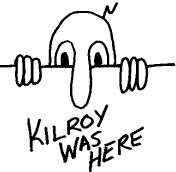Kilroy was here
Q From Leif B Christensen in Denmark: Would you please tell me where the phrase Kilroy was here originated?
A Nobody knows where the name of this archetypal American came from, though the expression turned up on walls and equipment all over the world during World War II. It seemed that the existence of a flat surface was an invitation for somebody to scrawl Kilroy was here! on it.
The best-known story links the expression with James J Kilroy, of Halifax, Massachusetts. This is how the New York Times explained matters on 24 December 1946:
During the war he was employed at the Bethlehem Steel Company’s Quincy shipyard, inspecting tanks, double bottoms and other parts of warships under construction. To satisfy superiors that he was performing his duties, Mr. Kilroy scribbled in yellow crayon ‘Kilroy was here’ on inspected work. Soon the phrase began to appear in various unrelated places, and Mr. Kilroy believes the 14,000 shipyard workers who entered the armed services were responsible for its subsequent world-wide use.
This has been widely believed and is stated as fact in several books on phrase origins. Unfortunately, there are several other claims by individuals to have originated it, including this one that was reported in the Nevada State Journal on 2 December 1945:
The mystery of World War II’s most frequently chalked inscription — “Kilroy was here” — apparently has been solved. Veterans, who have seen that curious phrase on buildings, aircraft fuselages and piers wherever Americans have fought, will be happy to know that Sgt. Francis J. Kilroy, Jr., a 21-year-old Everett soldier, was responsible. Now awaiting a discharge at Davis-Monthan field, Tucson, Ariz., Kilroy informed his parents here that while he was hospitalized earlier in the war a friend scrawled on a bulletin board at a Florida airbase: “Kilroy will be here next week.” Airmen carried it overseas and left millions of veterans guessing until now.
The Oxford English Dictionary says firmly that Kilroy was “The name of a mythical person” and there’s nothing in the historical record or in people’s memories to gainsay that. The problem for scholars is that stories about him only began to circulate at the end of the War. Among the first references are those in various editions of Stars and Stripes from August 1945 onwards; however, Fred Shapiro says in the Yale Dictionary of Quotations that Kilroy’s earliest appearance was in the Kearns Air Force Post Review on 26 June 1945: “To the Unknown Soldier — Kilroy Sleeps Here.” Eric Partridge stated in his Dictionary of Slang and Unconventional English that it started in America around 1940, before the entry of the US into the War (which would rule out all the claimed attributions and, presumably, a military origin), but he gives no evidence.

Incidentally, the expression was often accompanied by a cartoon figure of a little man looking over a wall. This was actually a British invention. In its native land the figure would say things like “Wot? No bread?” as comments on shortages during and after the War. To the British man in the street he was known as Mr Chad (no relative of the notorious chad of a recent US presidential election). Chad was carried abroad by British servicemen and at some point during the War he and Kilroy joined forces. It is said that Mr Chad was the invention of George Chatterton, a British cartoonist, about 1938. Chatterton’s nickname was Chat and the shift to Chad is easy to imagine.
And as an unserious postscript, you may like a little rhyme from A Diller, a Dollar: Rhymes And Sayings For The Ten O’clock Scholar, compiled by Lillian Morrison and published in 1955:
“Clap my hands and jump for joy;
I was here before Kilroy.”
“Sorry to spoil your little joke;
I was here, but my pencil broke.”
— Kilroy
